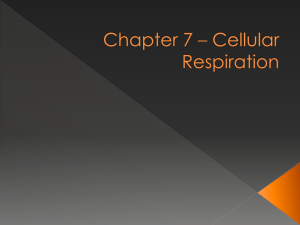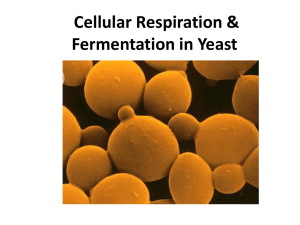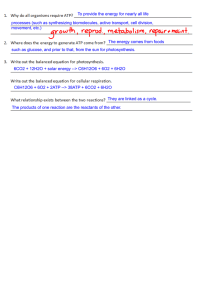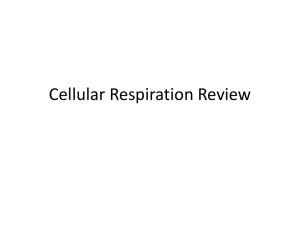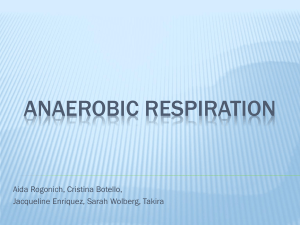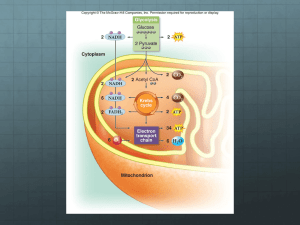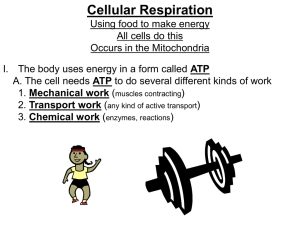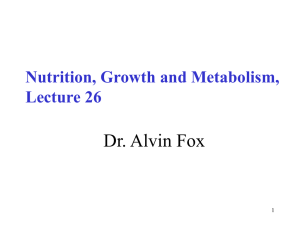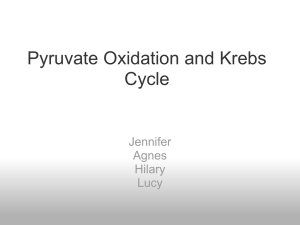Cellular Respiration
advertisement
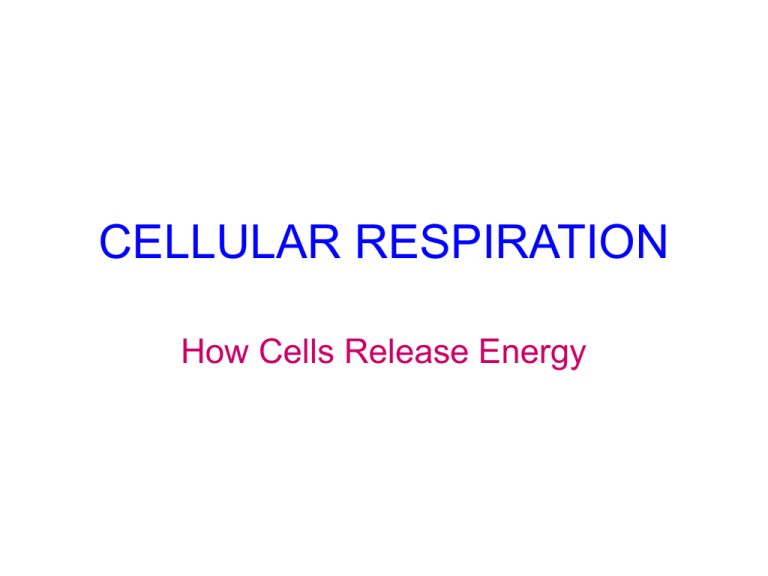
CELLULAR RESPIRATION How Cells Release Energy Cellular Respiration Anaerobic Cellular Respiration Aerobic Cellular Respiration 1. Glycolysis 1. Glycolysis 2. Fermentation 3. Krebs Cycle 4. Electron Transport System Anaerobic Cellular Respiration 1. Glycolysis 2. Fermentation 1. Glycolysis Takes place in the cytoplasm of all cells (Sugar Splitting) C6H12O6 Glucose 2 ADP 2 ATP 2 NAD+ 2 NADH Pyruvate Pyruvate 2. Fermentation Alcoholic Fermentation Pyruvate 2 NADH Alcohol 2 NAD+ + CO2 The Significance of fermentation is to regenerate NAD+ from NADH for its continuous role in glycolysis 2. Fermentation Lactic Acid Fermentation Pyruvate 2 NADH 2 NAD+ Lactic acid The Significance of fermentation is to regenerate NAD+ from NADH for its continuous role in glycolysis Fermentation does NOT produce additional ATP The Significance of fermentation is to regenerate NAD+ from NADH for its continuous role in glycolysis During anaerobic cellular respiration only 2 ATP are produced from one initial glucose molecule Aerobic Cellular Respiration 1. Glycolysis 3. Krebs Cycle: Step a 3. Krebs Cycle 3. Krebs Cycle: Step b 4. Electron Transport System 1. Glycolysis Takes place in the cytoplasm of all cells (Sugar Splitting) C6H12O6 Glucose 2 ADP 2 ATP 2 NAD+ 2 NADH Pyruvate Pyruvate The output of Glycolysis is: 2 ATP 2 NADH The 2 pyruvates produced by glycolysis in the cytoplasm are transported into the mitochondrion to continue aerobic cellular respiration in Krebs cycle 3. Krebs Cycle Takes place in the mitochondrion Step a 1 CO2 1 NADH 1st pyruvate Acetyl group + CoA Acetyl-CoA CoA 3. Krebs Cycle Takes place in the mitochondrion Step a 1 CO2 1 NADH 2nd pyruvate Acetyl group + CoA Acetyl-CoA CoA The output of Krebs Cycle step a is: 2 CO2 2 NADH 3. Krebs Cycle Step b CoA 1st Acetyl-CoA + 2 CO2 4-C- compound 1 ATP 3 NADH 1 FADH2 6-C-Compound 3. Krebs Cycle Step b CoA 2nd Acetyl-CoA + 2 CO2 4-C- compound 1 ATP 3 NADH 1 FADH2 6-C-Compound The output of Krebs Cycle step b is: 2 ATP 4 CO2 6 NADH 2 FADH2 The output of Krebs Cycle The output of Krebs Cycle step a is: 2 CO2 2 NADH step b is: 2 ATP 4 CO2 6 NADH 2 FADH2 The output of Krebs Cycle both steps is: 2 ATP 6 CO2 8 NADH 2 FADH2 Summary of energy harvest • GLYCOLYSIS • 2 ATP • 2 NADH • • • • • Krebs Cycle: 2 ATP 6 CO2 8 NADH 2 FADH2 • 4 ATP can be used for cellular work • 6 CO2 are released • Raw materials for electron transport system: • 10 NADH • 2 FADH2 An Overview of the Electron Transport System The Electron Transport System 1. NADH and FADH2 pass electrons to the first protein in the electron transport system (ETS). 2. Electrons pass from energy carrier to the next. 3. With each transfer, energy is released 4. This energy is used to pump hydrogen ions into the outer compartment of the mitochondrion. 5. Hydrogen ions build up in the outer compartment (higher concentration of H+ in the outer compartment than in the matrix). 6. Hydrogen ions flow back across the membrane through an enzyme (ATP synthase) that synthesizes ATP 7. The last protein in the ETS finally passes electrons to oxygen along with hydrogen ions, generating water. The Electron Transport System Electron Transport System Most of ATP is produced during ETS ETS produces 32 ATP The Overall Equation of CR C6H12O6 + 6 O2 6 CO2 + 6 H2O + 36 ATP + Heat



